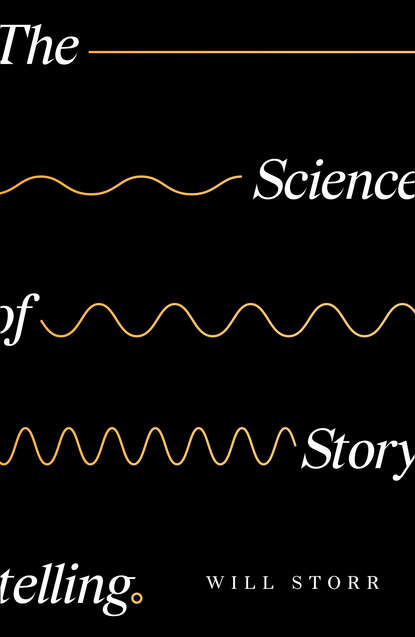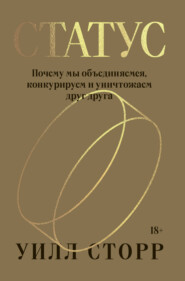По всем вопросам обращайтесь на: info@litportal.ru
(©) 2003-2024.
✖
The Science of Storytelling
Автор
Год написания книги
2019
Настройки чтения
Размер шрифта
Высота строк
Поля
We’ve been a social species, whose survival has depended upon human cooperation, for hundreds of thousands of years. But over the last 1,000 generations it’s been argued (#litres_trial_promo) that these social instincts have been rapidly honed and strengthened. This ‘sharp acceleration’ of selection for social traits, writes developmental psychologist Professor Bruce Hood, has left us with brains that are ‘exquisitely engineered to interact with other brains’.
For earlier humans that roamed hostile environments, aggression and physicality had been critical. But the more cooperative we became, the less useful these traits proved. When we started living in settled communities, they grew especially troublesome. There, it would’ve been the people who were better at getting along with others, rather than the physically dominant, who’d have been more successful.
This success in the community would’ve meant greater reproductive success, which would’ve gradually led to the emergence of a new strain of human. These humans had thinner and weaker bones than their ancestors and greatly reduced muscle mass, their physical strength as much as halving (#litres_trial_promo). They also had the kind of brain chemistry and hormones that predisposed them to behaviour specialised for settled communal living. They’d have been less interpersonally aggressive, but more adept at the kind of psychological manipulation necessary for negotiating, trading and diplomacy. They’d become expert at controlling their environment of other human minds.
You might compare it to the difference between a wolf and a dog. A wolf survives by cooperating as well as fighting for dominance and killing prey. A dog does so by manipulating its human owner such that they’d do anything for them. The power my beloved labradoodle Parker has over my own brain is frankly embarrassing. (I’ve dedicated this bloody book to her.) In fact, this might be more than a mere analogy. Researchers such as Hood argue that modern humans, just like dogs, have gone through a process of domestication. Support for the idea comes partly from the fact that, over the last 20,000 years, our brains have shrunk by between ten and fifteen per cent, the same reduction that’s been observed in all the thirty or so other animals that humans have domesticated. Just as with those creatures, our domestication means we’re tamer than our ancestors, better at reading social signals and more dependent on others. But, writes Hood, ‘no other animal has taken domestication to the extent that we have.’ Our brains may have initially evolved to ‘cope with a potentially threatening world of predators, limited food and adverse weather, but we now rely on it to navigate an equally unpredictable social landscape.’
Unpredictable humans. This is the stuff of story.
For modern humans, controlling the world means controlling other people, and that means understanding them. We’re wired to be fascinated by others and get valuable information from their faces. This fascination begins almost immediately. Whereas ape and monkey parents (#litres_trial_promo) spend almost no time looking at their babies’ faces, we’re helplessly drawn to them. Newborns are attracted to human faces more than to any other object (#litres_trial_promo) and, one hour from birth, begin imitating them (#litres_trial_promo). By two, they’ve learned to control their social worlds by smiling (#litres_trial_promo). By the time they’re adults, they’ve become so adept at reading people that they’re making calculations about status and character automatically, in one tenth of a second (#litres_trial_promo). The evolution of our strange, extremely other-obsessed brains has brought with it weird side-effects. Human obsession with faces is so fierce we see them almost anywhere: in fire; in clouds; down spooky corridors; in toast.
We sense minds everywhere too. Just as the brain models the outside world it also builds models of minds. This skill, which is an essential weapon in our social armoury, is known as ‘theory of mind’. It enables us to imagine what others are thinking, feeling and plotting, even when they’re not present. We can experience the world from another’s perspective. For the psychologist Professor Nicholas Epley this capacity, which is obviously essential for storytelling, gave us incredible power. ‘Our species has conquered the Earth because (#litres_trial_promo) of our ability to understand the minds of others,’ he writes, ‘not because of our opposable thumbs or handiness with tools.’ We develop this skill at around the age of four. It’s then that we become story-ready; equipped to understand the logic of narrative.
The human ability to populate our minds with imagined other minds is the start of religion. Shamans in hunter-gatherer tribes would enter trance states and interact with spirits, and use these interactions as attempts to control the world. Religions were also typically animistic: our storytelling brains would project human-like minds into trees, rocks, mountains and animals, imagining they were possessed by gods who were responsible for changeful events, and required controlling with ritual and sacrifice.
Childhood stories reflect our natural tendency for such hyperactive mind-detecting. In fairytales, human-like minds are everywhere: mirrors talk, pigs eat breakfast, frogs turn into princes. Youngsters naturally treat their dolls and teddies as if they’re inhabited by selves. I remember feeling terrible guilt for preferring my pink bear, handmade by my Grandmother, to my shop-bought brown bear. I knew they both knew how I felt, and that left me distracted and sad.
We never really grow out of our inherent animism. Which one of us hasn’t kicked a door that’s slammed on our fingers believing, in that disorientating flash of pain, that it attacked us out of spite? Who among us hasn’t told a self-assembly wardrobe to fuck off? Whose storytelling brain doesn’t commit its own literary-style pathetic fallacy, allowing the sun to make them optimistic about the coming day or the brooding clouds pessimistic? Studies indicate that those who anthropomorphise (#litres_trial_promo) a human personality onto their cars show less interest in trading them. Bankers project human moods (#litres_trial_promo) onto the movements of the markets and place their trades accordingly.
When we’re reading, hearing or watching a story we deploy our theory-of-mind skills by automatically making hallucinatory models of the minds of its characters. Some authors model the minds of their own characters with such force that they hear them talk. Charles Dickens, William Blake and Joseph Conrad all spoke of (#litres_trial_promo) such extraordinary experiences. The novelist and psychologist Professor Charles Fernyhough (#litres_trial_promo) has led research in which 19 per cent of ordinary readers reported hearing the voices of fictional characters even after they’d put their books down. Some reported a kind of literary possession, with the character influencing the tone and nature of their thoughts.
But much as humans excel at such feats of theory of mind, we also tend to dramatically overestimate our abilities. Although there’s an admitted absurdity in claiming to be able to quantify human behaviour with such absolute numerical precision, some research suggests strangers read another’s thoughts (#litres_trial_promo) and feelings with an accuracy of just 20 per cent. Friends and lovers? A mere 35 per cent. Our errors about what others are thinking are a major cause of human drama. As we move through life, wrongly predicting what people are thinking and how they’ll react when we try to control them, we haplessly trigger feuds and fights and misunderstandings that fire devastating spirals of unexpected change into our social worlds.
Comedy, whether by William Shakespeare or John Cleese and Connie Booth, is often built on such mistakes. But whatever the mode of storytelling, well-imagined characters always have theories about the minds of other characters and – because this is drama – those theories will often be wrong.This wrongness will lead to unexpected consequences and yet more drama. The influential post-war director Alexander Mackendrick writes, ‘I start by asking (#litres_trial_promo): What does A think B is thinking about A? It sounds complicated (and it is) but this is the very essence of giving some density to a character and, in turn, a scene.’
The author Richard Yates uses a theory-of-mind mistake to create a pivotal moment of drama in his classic Revolutionary Road. The novel charts the dissolving marriage of Frank and April Wheeler. When they were young, and newly in love, Frank and April dreamed of bohemian lives in Paris. But, when we meet them, middle-aged reality has struck. Frank and April have two children, with a third on the way, and have moved into a cookie-cutter suburb. Frank’s secured a job at his father’s old company and has found himself rather settling into a life of boozy lunches and housewife-at-home ease. But April isn’t happy. She still dreams of Paris. They argue, bitterly. Sex is withheld. Frank sleeps with a girl at work. And then he makes his theory-of-mind mistake.
In order to break the impasse with his wife, Frank decides to confess his infidelity. His theory of April’s mind appears to be that she’ll be thrown into a state of catharsis that will jolt her back into reality. There’ll be tears to mop up, sure, but those tears will just remind the ol’ gal why she loves him.
This is not what happens. When he confesses, April asks, Why? Not why he slept with the girl, but why is he bothering to tell her? She doesn’t care about his fling. This isn’t what Frank was expecting at all. He wants her to care! ‘I know you do,’ April tells him. ‘And I suppose I would, if I loved you; but you see I don’t. I don’t love you and I never really have and I never really figured it out until this week.’
1.6 (#ulink_460951b8-1cd9-5554-af34-d052f05473fe)
As the eye darts about, building up its story world for you to live inside, the brain’s choosy about where it tells it to look. We’re attracted to change, of course, but also to other salient details. Scientists used to believe attention was drawn simply to objects that stood out, but recent research suggests we’re more likely to attend to (#litres_trial_promo) that which we find meaningful. Unfortunately, it’s not yet known precisely what ‘meaningful’ means, in this context, but tests that tracked saccades found, for example, that an untidy shelf attracted more attention than a sun-splashed wall. For me, that untidy shelf hints of human change; of a life in detail; of trouble insinuating itself in a place designed for order. It’s no surprise test-brains were drawn to it. It’s story-stuff, whilst the sun is just a shrug.
Storytellers also choose carefully what meaningful details to show and when. In Revolutionary Road, just after Frank makes his changeful theory-of-mind mistake that throws his life in a new and unexpected direction, the author draws our attention to one brilliant detail. It’s an urgent voice on the radio: ‘And listen to this. Now, during the Fall Clearance, you’ll find Robert Hall’s entire stock of men’s walk shorts and sport jeans drastically reduced!’
Both believable and crushing, it serves to intensify our feelings, at exactly the right moment, of the suffocating and dreary housewifey corner that April has found herself backed into. Its timing also implicitly defines and condemns what Frank has become. He used to think he was bohemian – a thinker! – and now he’s just Bargain Shorts Man. This is an advert for him.
The director Stephen Spielberg is famous for his use of salient detail to create drama. In Jurassic Park, during a scene that builds to our first sighting of Tyrannosaurusrex, we see two cups of water on a car dashboard, deep rumbles from the ground sending rings over their liquid surface. We cut between the faces of the passengers, each slowly registering change. Then we see the rear-view mirror vibrating with the stomping of the beast. Extra details like this add even more tension by mimicking the way brains process peak moments of stress. When we realise our car is about to crash, say, the brain needs to temporarily increase its ability to control the world. Its processing power surges and we become aware of more features in our environment, which has the effect of making time seem to slow down. In exactly this way, storytellers stretch time, and thereby build suspense, by packing in extra saccadic moments and detail.
1.7 (#ulink_b54c082b-01ce-50c6-a302-0bae76ea8f68)
There’s a park bench, in my hometown, that I don’t like to walk past because it’s haunted by a breakup with my first love. I see ghosts on that bench that are invisible to anyone else except, perhaps, her. And I feel them too. Just as human worlds are haunted with minds and faces, they’re haunted with memories. We think of the act of ‘seeing’ as the simple detection of colour, movement and shape. But we see with our pasts.
That hallucinatory neural model of the world we live inside is made up of smaller, individual models – we have neural models of park benches, dinosaurs, ISIS, ice cream, models of everything – and each of those is packed with associations from our own personal histories. We see both the thing itself and all that we associate with it. We feel it too. Everything our attention rests upon triggers a sensation, most of which are minutely subtle and experienced beneath the level of conscious awareness. These feelings flicker and die so rapidly that they precede conscious thought, and thereby influence it. All these feelings reduce to just two impulses: advance and withdraw. As you scan any scene, then, you’re in a storm of feeling; positive and negative sensations from the objects you see fall over you like fine drops of rain. This understanding is the beginning of creating a compelling and original character on the page. A character in fiction, like a character in life, inhabits their own unique hallucinated world in which everything they see and touch comes with its own unique personal meaning.
These worlds of feeling are a result of the way our brains encode the environment. The models we have of everything are stored in the form of neural networks. When our attention rests upon a glass of red wine, say, a large number of neurons in different parts of the brain are simultaneously activated. We don’t have a specific ‘glass of wine’ area that lights up, what we have are responses to ‘liquid’, ‘red’, ‘shiny surface’, ‘transparent surface’, and so on. When enough of these are triggered, the brain understands what’s in front of it and constructs the glass of wine for us to ‘see’.
But these neural activations aren’t limited to mere descriptions of appearance. When we detect the glass of wine, other associations also flash into being: bitter-sweet flavours; vineyards; grapes; French culture; dark marks on white carpets; your road-trip to the Barossa Valley; the last time you got drunk and made a fool of yourself; the first time you got drunk and made a fool of yourself; the breath of the woman who attacked you. These associations have powerful effects on our perception. Research shows that when we drink (#litres_trial_promo) wine our beliefs about its quality and price change our actual experience of its taste. The way food is described (#litres_trial_promo) has a similar effect.
It’s just such associative thinking that gives poetry its power. A successful poem plays on our associative networks as a harpist plays on strings. By the meticulous placing of a few simple words, they brush gently against deeply buried memories, emotions, joys and traumas, which are stored in the form of neural networks that light up as we read. In this way, poets ring out rich chords of meaning that resonate so profoundly we struggle to fully explain why they’re moving us so.
Alice Walker’s ‘Burial’ describes the poet bringing her child to the cemetery in Eatonton, Georgia, in which several generations of her family are interred. She describes her grandmother resting
undisturbed
beneath the Georgia sun,
above her the neatstepping hooves
of cattle
and graves that ‘drop open without warning’ and
cover themselves with wild ivy
blackberries. Bittersweet and sage.
No one knows why. No one asks.
When I read ‘Burial’ for the first time, the lines at the end of this stanza made little logical sense to me, and yet I immediately found them beautiful, memorable and sad:
Forgetful of geographic resolutions as birds
the far-flung young fly South to bury
the old dead.
It’s these same associative processes that allow us to think metaphorically. Analyses of language reveal the extraordinary fact that we use around one metaphor for every ten seconds of speech (#litres_trial_promo) or written word. If that sounds like too much, it’s because you’re so used to thinking metaphorically – to speaking of ideas that are ‘conceived’ or rain that is ‘driving’ or rage that is ‘burning’ or people who are ‘dicks’. Our models are not only haunted by ourselves, then, but also by properties of other things. In her 1930 essay ‘Street Haunting’ Virginia Woolf employs several subtle metaphors over the course of a single gorgeous sentence:
How beautiful a London street is then, with its islands of lights, and its long groves of darkness, and on the side of it perhaps some tree-sprinkled, grass-grown space where night is folding herself to sleep naturally and, as one passes the iron railing, one hears those little cracklings and stirrings of leaf and twig which seem to suppose the silence of fields all around them, an owl hooting, and far away the rattle of the train in the valley.
Neuroscientists are building a powerful case (#litres_trial_promo) that metaphor is far more important to human cognition than has ever been imagined. Many argue it’s the fundamental way that brains understand abstract concepts, such as love, joy, society and economy. It’s simply not possible to comprehend these ideas in any useful sense, then, without attaching them to concepts that have physical properties: things that bloom and warm and stretch and shrink.
Metaphor (and its close sibling, the simile) tends to work on the page in one of two ways. Take this example, from Michael Cunningham’s A Home at the End of the World: ‘She washed old plastic bags and hung them on the line to dry, a string of thrifty tame jellyfish floating in the sun.’ This metaphor works principally by opening an information gap. It asks the brain a question: how can a plastic bag be a jellyfish? To find the answer, we imagine the scene. Cunningham has nudged us into more vividly modelling his story.
In Gone with the Wind, Margaret Mitchell uses metaphor to make not a visual point, but a conceptual one: ‘The very mystery of him excited her curiosity like a door that had neither lock nor key.’
In The Big Sleep, metaphor enables Raymond Chandler to pack a tonne of meaning into just seven words: ‘Dead men are heavier than broken hearts.’
Brain scans illustrate the second, more powerful, use of metaphor. When participants in one study read the words ‘he had a rough day’ (#litres_trial_promo), their neural regions involved in feeling textures became more activated, compared with those who read ‘he had a bad day’. In another, those who read ‘she shouldered the burden’ (#litres_trial_promo) had neural regions associated with bodily movement activated more than when they read ‘she carried the burden’. This is prose writing that deploys the weapons of poetry. It works because it activates extra neural models that give the language additional meaning and sensation. We feel the heft and strain of the shouldering, we touch the abrasiveness of the day.
Such an effect is exploited by Graham Greene in The Quiet American. Here, a protagonist with a broken leg is receiving unwanted help from his antagonist: ‘I tried to move away from him and take my own weight, but the pain came roaring back like a train in a tunnel.’ This finely judged metaphor is enough to make you wince. You can almost feel the neural networks firing up and borrowing greedily from each other: the tender limb; the snapped bone; the pain in all its velocity and unstoppableness and thunder, roaring up the tunnel of the leg.
In The God of Small Things, Arundhati Roy uses metaphorical language to sensual effect when describing a love scene between the characters Ammu and Valutha: ‘She could feel herself through him. Her skin. The way her body existed only where he touched her. The rest of her was smoke.’
And here the eighteenth-century writer and critic Denis Diderot uses a one-two of perfectly contrasting similes to smack his point home: ‘Libertines are hideous spiders, that often catch pretty butterflies.’









